《大学英语读写》课程教学资源(A)Ⅱ_四级资源_听力_大学英语四级听力测试概述
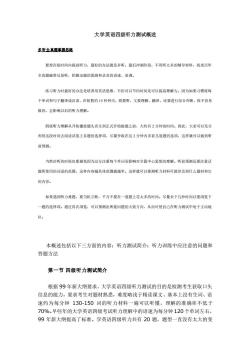
大学英语四级听力测试概述多听全真题举握思路要想在短时间内提高听力,最好的办法就是多听。最后冲刺阶段,不用听太多的辅导材料,找来历年全真题磁带反复听,把握出题的思路和录音的语速、语调。练习听力时最好的办法是培养用英语思维,不但可以节约时间还可以提高理解力。因为如果习惯将每个单词和句子翻译成汉语,在短暂的15秒钟内,既要听,又要理解、翻译,还要进行综合判断,很不容易做到,会影响以后的听力理解。四级听力理解从开始播放题头音乐到正式开始做题之前,大约有2分钟的时间。因此,大家可以充分利用这段时间去阅读试卷上各题的选择项,尽量争取在这2分钟内多看几道题的选项,这样就可以做到听前预测。当然在听的时候也要避免因为过分注重每个单词而影响对全篇中心思想的理解。听前预测还要注意话题所使用的词语的范围,这种内容越具体范围就越窄。这样就可以推测听力材料可能涉及到什么题材和它的内容。如果遇到听力难题,要当机立断,千万不要在一道题上花太多的时间。尽量余下几秒时间以便浏览下一题的选择项。通过再次浏览,可以预测出所提问题的大致方向,从而可使自已在听力测试中处于主动地位。本概述包括以下三方面的内容:听力测试简介;听力训练中应注意的问题和答题方法第一节四级听力测试简介根据99年新大纲要求,大学英语四级听力测试的目的是检测考生获取口头信息的能力,要求考生对题材熟悉,难度略浅于精读课文、基本上没有生词、语速约为每分钟130-150词的听力材料一遍可以听懂,理解的准确率不低于70%。早些年的大学英语四级考试听力理解中的语速为每分钟120个单词左右,99年新大纲提高了标准。学英语四级听力共有20题,题型一直没有太大的变
大学英语四级听力测试概述 多听全真题掌握思路 要想在短时间内提高听力,最好的办法就是多听。最后冲刺阶段,不用听太多的辅导材料,找来历年 全真题磁带反复听,把握出题的思路和录音的语速、语调。 练习听力时最好的办法是培养用英语思维,不但可以节约时间还可以提高理解力。因为如果习惯将每 个单词和句子翻译成汉语,在短暂的 15 秒钟内,既要听,又要理解、翻译,还要进行综合判断,很不容易 做到,会影响以后的听力理解。 四级听力理解从开始播放题头音乐到正式开始做题之前,大约有 2 分钟的时间。因此,大家可以充分 利用这段时间去阅读试卷上各题的选择项,尽量争取在这 2 分钟内多看几道题的选项,这样就可以做到听 前预测。 当然在听的时候也要避免因为过分注重每个单词而影响对全篇中心思想的理解。听前预测还要注意话 题所使用的词语的范围,这种内容越具体范围就越窄。这样就可以推测听力材料可能涉及到什么题材和它 的内容。 如果遇到听力难题,要当机立断,千万不要在一道题上花太多的时间。尽量余下几秒时间以便浏览下 一题的选择项。通过再次浏览,可以预测出所提问题的大致方向,从而可使自己在听力测试中处于主动地 位。 本概述包括以下三方面的内容:听力测试简介;听力训练中应注意的问题和 答题方法 第一节 四级听力测试简介 根据 99 年新大纲要求,大学英语四级听力测试的目的是检测考生获取口头 信息的能力,要求考生对题材熟悉,难度略浅于精读课文、基本上没有生词、语 速约为每分钟 130-150 词的听力材料一遍可以听懂,理解的准确率不低于 70%。早些年的大学英语四级考试听力理解中的语速为每分钟 120 个单词左右, 99 年新大纲提高了标准。学英语四级听力共有 20 题,题型一直没有太大的变
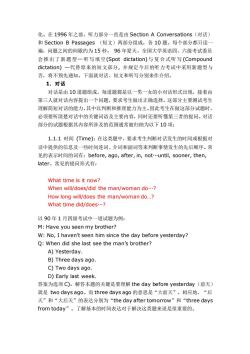
化。在1996年之前,听力部分一直是由SectionAConversations(对话)和SectionBPassages(短文)两部分组成,各10题。每个部分都只读一遍,问题之间的间歇约为15秒。96年夏天,全国大学英语四、六级考试委员会推出了新题型一写填空(Spotdictation)与复合式听写(Compounddictation)一代替原来的短文部分,并规定今后的听力考试中采用新题型与否,将不预先通知。下面就对话、短文和听写分别来作介绍。1.对话对话是由10道题组成,每道题都是以一男一女的小对话形式出现,接着由第三人就对话内容提出一个问题,要求考生做出正确选择。这部分主要测试考生理解简短对话的能力,其中以判断和推理能力为主。因此考生在做这部分试题时,必须要听清楚对话中的关键词语及主要内容,同时还要听懂第三者的提问。对话部分的试题根据其内容所涉及的范围通常被归纳为以下10项:1.1.1时间(Time):在这类题中,要求考生判断对话发生的时间或根据对话中提供的信息及一些时间连词、介词和副词等来判断事情发生的先后顺序。常见的表示时间的词有:before,ago,after,in,notuntil,sooner,then,later。常见的提问形式有:What time is it now?When will/does/did the man/woman do...?How long will/does theman/womando...?Whattimedid/does..?以90年1月四级考试中一道试题为例:M:Haveyou seenmybrother?W:No,I haven't seen him sincethedaybeforeyesterday?Q:Whendidshelastseetheman'sbrother?A)Yesterday.B) Three days ago.C) Two days ago.D)Earlylast week答案为选项C)。解答本题的关键是要理解thedaybeforeyesterday(前天)就是twodaysago。而threedaysago的意思是“大前天”。相应地,“后天”和“大后天”的表达分别为“thedayaftertomorrow”和“threedaysfromtoday”。了解基本的时间表达对于解决这类题来说是很重要的
化。在 1996 年之前,听力部分一直是由 Section A Conversations(对话) 和 Section B Passages (短文)两部分组成,各 10 题。每个部分都只读一 遍,问题之间的间歇约为 15 秒。 96 年夏天,全国大学英语四、六级考试委员 会推出了新题型— 听写填空(Spot dictation)与 复合式听写 (Compound dictation) —代替原来的短文部分, 并规定今后的听力考试中采用新题型与 否,将不预先通知。下面就对话、短文和听写分别来作介绍。 1.对话 对话是由 10 道题组成,每道题都是以一男一女的小对话形式出现,接着由 第三人就对话内容提出一个问题,要求考生做出正确选择。这部分主要测试考生 理解简短对话的能力,其中以判断和推理能力为主。因此考生在做这部分试题时, 必须要听清楚对话中的关键词语及主要内容,同时还要听懂第三者的提问。对话 部分的试题根据其内容所涉及的范围通常被归纳为以下 10 项: 1.1.1 时间 (Time):在这类题中,要求考生判断对话发生的时间或根据对 话中提供的信息及一些时间连词、介词和副词等来判断事情发生的先后顺序。常 见的表示时间的词有:before, ago, after, in, not.until, sooner, then, later。常见的提问形式有: What time is it now? When will/does/did the man/woman do.? How long will/does the man/woman do.? What time did/does.? 以 90 年 1 月四级考试中一道试题为例: M: Have you seen my brother? W: No, I haven’t seen him since the day before yesterday? Q: When did she last see the man’s brother? A) Yesterday. B) Three days ago. C) Two days ago. D) Early last week. 答案为选项 C)。解答本题的关键是要理解 the day before yesterday(前天) 就是 two days ago。而 three days ago 的意思是“大前天”。相应地,“后 天”和“大后天”的表达分别为“the day after tomorrow”和“three days from today”。了解基本的时间表达对于解决这类题来说是很重要的
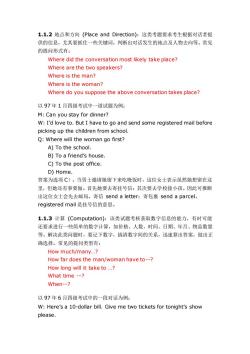
1.1.2地点和方向(PlaceandDirection):这类考题要求考生根据对话者提供的信息,尤其要抓住一些关键词,判断出对话发生的地点及人物去向等。常见的提问形式有:Where did the conversationmost likely takeplace?Where are the two speakers?Where is the man?Whereisthewoman?Where do you suppose the above conversationtakesplace?以97年1月四级考试中一道试题为例:M: Can you stay for dinner?W:I'd love to.But I have togo and send some registered mail beforepickingupthechildrenfromschool.Q:Where will the woman go first?A) To the school.B) To a friend's house.C) To the post office.D) Home.答案为选项C)。当男士邀请她留下来吃晚饭时,这位女士表示虽然她想留在这里,但她还有事要做。首先她要去寄挂号信;其次要去学校接小孩。因此可推断出这位女士会先去邮局。寄信sendaletter:寄包裹sendaparcel。registeredmail是挂号信的意思。1.1.3计算(Computation):该类试题考核获取数字信息的能力,有时可能还要求进行一些简单的数字计算,如价格、人数、时间、日期、年月、物品数量等。解决此类问题时,要记下数字,搞清数字间的关系,迅速算出答案,做出正确选择。常见的提问类型有:How much/many...?Howfardoestheman/womanhaveto..?How long will it take to ...?What time....?When..?以97年6月四级考试中的一段对话为例:W:Here'sa10-dollarbill.Givemetwoticketsfortonight'sshowplease
1.1.2 地点和方向 (Place and Direction):这类考题要求考生根据对话者提 供的信息,尤其要抓住一些关键词,判断出对话发生的地点及人物去向等。常见 的提问形式有: Where did the conversation most likely take place? Where are the two speakers? Where is the man? Where is the woman? Where do you suppose the above conversation takes place? 以 97 年 1 月四级考试中一道试题为例: M: Can you stay for dinner? W: I’d love to. But I have to go and send some registered mail before picking up the children from school. Q: Where will the woman go first? A) To the school. B) To a friend’s house. C) To the post office. D) Home. 答案为选项 C)。当男士邀请她留下来吃晚饭时,这位女士表示虽然她想留在这 里,但她还有事要做。首先她要去寄挂号信;其次要去学校接小孩。因此可推断 出这位女士会先去邮局。寄信 send a letter;寄包裹 send a parcel。 registered mail 是挂号信的意思。 1.1.3 计算 (Computation):该类试题考核获取数字信息的能力,有时可能 还要求进行一些简单的数字计算,如价格、人数、时间、日期、年月、物品数量 等。解决此类问题时,要记下数字,搞清数字间的关系,迅速算出答案,做出正 确选择。常见的提问类型有: How much/many.? How far does the man/woman have to.? How long will it take to .? What time .? When.? 以 97 年 6 月四级考试中的一段对话为例: W: Here’s a 10-dollar bill. Give me two tickets for tonight’s show please
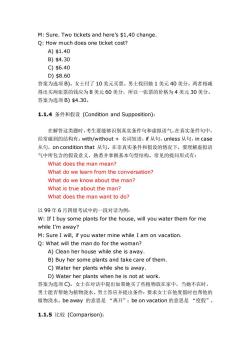
M:Sure.Twoticketsandhere's$1,40change.Q: How much does one ticket cost?A) $1.40B) $4.30C) $6.40D) $8.60答案为选项B)。女士付了10美元买票。男士找回她1美元40美分。两者相减得出买两张票的钱应为8美元60美分,所以一张票的价格为4美元30美分。答案为选项B)$4.30。1.1.4条件和假设(ConditionandSupposition):在解答这类题时,考生要能够识别真实条件句和虚拟语气。在真实条件句中,经常碰到的结构有:with/without+名词短语,if从句,unless从句,incase从句,onconditionthat从句。在非真实条件和假设的情况下,要理解虚拟语气中所包含的假设意义,熟悉并掌握基本句型结构。常见的提问形式有:What does the man mean?What do we learn from the conversation?What do we know about theman?What is true about the man?What does the man want to do?以99年6月四级考试中的一段对话为例:W:IfIbuysomeplantsforthehouse,willyouwaterthemformewhile I'm away?M:SureI will,if youwaterminewhile I amonvacation.Q:Whatwill themandoforthewoman?A)Clean herhouse while she isaway,B)Buy her someplants and takecareof them.C) Water her plants while she is away.D) Water her plants when he is not at work.答案为选项C)。女士在对话中提出如果她买了些植物放在家中,当她不在时,男士能否帮她为植物浇水。男士答应并提出条件:要求女士在他度假时也帮他的植物浇水。beaway的意思是“离开”;beonvacation的意思是“度假”。1.1.5比较(Comparison):
M: Sure. Two tickets and here’s $1,40 change. Q: How much does one ticket cost? A) $1.40 B) $4.30 C) $6.40 D) $8.60 答案为选项 B)。女士付了 10 美元买票。男士找回她 1 美元 40 美分。两者相减 得出买两张票的钱应为 8 美元 60 美分,所以一张票的价格为 4 美元 30 美分。 答案为选项 B) $4.30。 1.1.4 条件和假设 (Condition and Supposition): 在解答这类题时,考生要能够识别真实条件句和虚拟语气。在真实条件句中, 经常碰到的结构有:with/without + 名词短语,if 从句,unless 从句,in case 从句,on condition that 从句。在非真实条件和假设的情况下,要理解虚拟语 气中所包含的假设意义,熟悉并掌握基本句型结构。常见的提问形式有: What does the man mean? What do we learn from the conversation? What do we know about the man? What is true about the man? What does the man want to do? 以 99 年 6 月四级考试中的一段对话为例: W: If I buy some plants for the house, will you water them for me while I’m away? M: Sure I will, if you water mine while I am on vacation. Q: What will the man do for the woman? A) Clean her house while she is away. B) Buy her some plants and take care of them. C) Water her plants while she is away. D) Water her plants when he is not at work. 答案为选项 C)。女士在对话中提出如果她买了些植物放在家中,当她不在时, 男士能否帮她为植物浇水。男士答应并提出条件:要求女士在他度假时也帮他的 植物浇水。be away 的意思是 “离开”;be on vacation 的意思是 “度假”。 1.1.5 比较 (Comparison):
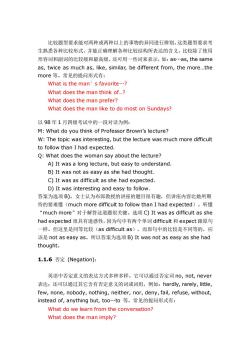
比较题型要求能对两种或两种以上的事物的异同进行辨别。这类题型要求考生熟悉各种比较形式,并能正确理解各种比较结构所表达的含义。比较除了使用形容词和副词的比较级和最高级,还可用一些词来表示,如:asas,thesameas, twice as much as, like, similar, be different from, the more...themore等。常见的提问形式有:What is the man's favorite...?What does the man think of...?What does the man prefer?Whatdoestheman like todomost on Sundays?以98年1月四级考试中的一段对话为例M:What do youthink of ProfessorBrown'slecture?W:The topic was interesting,but thelecture was much more difficultto follow than I had expected.Q: What does the woman say about the lecture?A)Itwasalonglecture,buteasytounderstand.B) It was not as easy as she had thought.C) It was as difficult as she had expected.D) It was interesting and easy to follow.答案为选项B)。女士认为布郎教授的讲座的题目很有趣,但讲座内容比她所期待的要难懂(muchmoredifficulttofollowthanIhadexpected)。听懂“muchmore”对于解答这道题很关键。选项C)Itwasasdifficultasshehadexpected很具有迷惑性,因为句中有两个单词difficult和expect跟原句一样。但这里是同等比较(asdifficultas),而原句中的比较是不同等的,应该是notaseasyas。所以答案为选项B)Itwasnotaseasyasshehadthought。1.1.6否定(Negation):英语中否定意义的表达方式多种多样。它可以通过否定词no,not,never表达;还可以通过其它含有否定意义的词或词组,例如:hardly,rarely,little,few, none, nobody,nothing, neither, nor, deny,fail, refuse, without,insteadof,anythingbut,tooto等。常见的提问形式有:Whatdowelearnfromtheconversation?What does the man imply?
比较题型要求能对两种或两种以上的事物的异同进行辨别。这类题型要求考 生熟悉各种比较形式,并能正确理解各种比较结构所表达的含义。比较除了使用 形容词和副词的比较级和最高级,还可用一些词来表示,如:as.as, the same as, twice as much as, like, similar, be different from, the more.the more 等。常见的提问形式有: What is the man’s favorite.? What does the man think of.? What does the man prefer? What does the man like to do most on Sundays? 以 98 年 1 月四级考试中的一段对话为例: M: What do you think of Professor Brown’s lecture? W: The topic was interesting, but the lecture was much more difficult to follow than I had expected. Q: What does the woman say about the lecture? A) It was a long lecture, but easy to understand. B) It was not as easy as she had thought. C) It was as difficult as she had expected. D) It was interesting and easy to follow. 答案为选项 B)。女士认为布郎教授的讲座的题目很有趣,但讲座内容比她所期 待的要难懂(much more difficult to follow than I had expected)。听懂 “much more”对于解答这道题很关键。选项 C) It was as difficult as she had expected 很具有迷惑性,因为句中有两个单词 difficult 和 expect 跟原句 一样。但这里是同等比较(as difficult as),而原句中的比较是不同等的,应 该是 not as easy as。所以答案为选项 B) It was not as easy as she had thought。 1.1.6 否定 (Negation): 英语中否定意义的表达方式多种多样。它可以通过否定词 no, not, never 表达;还可以通过其它含有否定意义的词或词组,例如:hardly, rarely, little, few, none, nobody, nothing, neither, nor, deny, fail, refuse, without, instead of, anything but, too.to 等。常见的提问形式有: What do we learn from the conversation? What does the man imply?
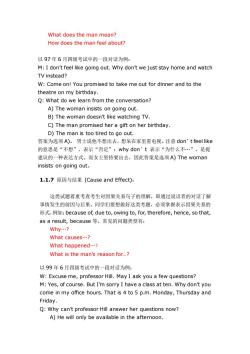
What does the man mean?How does the man feel about?以97年6月四级考试中的一段对话为例:M: I don't feel like going out. Why don't we just stay home and watchTVinstead?W:Come on!You promised to take me out for dinner and to thetheatre on my birthday.Q:What do we learn fromthe conversation?A) The woman insists on going out.B)Thewomandoesn't like watching TV.C) The man promised her a gift on her birthday.D) The man is too tired to go out.答案为选项A)。男士说他不想出去,想呆在家里看电视。注意dontfeellike的意思是“不想”,表示“否定”;whydon”t表示“为什么不”,是提建议的一种表达方式。而女士坚持要出去,因此答案是选项A)Thewomaninsists on going out.1.1.7原因与结果(CauseandEffect):这类试题着重考查考生对因果关系句子的理解,即通过说话者的对话了解事情发生的前因与后果。同学们要想做好这类考题,必须掌握表示因果关系的形式,例如becauseof,dueto,owingto,for,therefore,hence,sothat,asaresult,because等。常见的问题类型有:Why...?What causes...?What happened...?What is the man's reason for...?以99年6月四级考试中的一段对话为例:W:Excuse me,professor Hill.MayI ask youa few questions?M:Yes, of course.But I'm sorryI have a class at ten.Why don't youcomeinmy officehours.Thatis4 to5p.m.Monday,Thursday andFriday.Q:Whycan'tprofessorHill answerher questionsnow?A) He will only be available in the afternoon
What does the man mean? How does the man feel about? 以 97 年 6 月四级考试中的一段对话为例: M: I don’t feel like going out. Why don’t we just stay home and watch TV instead? W: Come on! You promised to take me out for dinner and to the theatre on my birthday. Q: What do we learn from the conversation? A) The woman insists on going out. B) The woman doesn’t like watching TV. C) The man promised her a gift on her birthday. D) The man is too tired to go out. 答案为选项 A)。 男士说他不想出去,想呆在家里看电视。注意 don’t feel like 的意思是“不想”,表示“否定”;why don’t 表示“为什么不.”,是提 建议的一种表达方式。而女士坚持要出去,因此答案是选项 A) The woman insists on going out。 1.1.7 原因与结果 (Cause and Effect): 这类试题着重考查考生对因果关系句子的理解,即通过说话者的对话了解 事情发生的前因与后果。同学们要想做好这类考题,必须掌握表示因果关系的 形式,例如:because of, due to, owing to, for, therefore, hence, so that, as a result, because 等。常见的问题类型有: Why.? What causes.? What happened.? What is the man’s reason for.? 以 99 年 6 月四级考试中的一段对话为例: W: Excuse me, professor Hill. May I ask you a few questions? M: Yes, of course. But I’m sorry I have a class at ten. Why don’t you come in my office hours. That is 4 to 5 p.m. Monday, Thursday and Friday. Q: Why can’t professor Hill answer her questions now? A) He will only be available in the afternoon

B)It'snothisofficehour.C) He doesn't have time.D)Heistootiredafterclass.答案为选项C。当这位女学生向professorHill问问题时,professor告诉她他下面接着有课,并请她在办公的时间来问。答案C他现在没有时间是正确答案。其它选项的意思分别为A)他只有在下午才有空;B)现在不是他办公的时间;D)上完课后他太累了。意思都与对话的含义不符。>下一页.1.8辨认(Identification):这类对话要求考生能够根据对话提供的信息,正确判断说话者的关系、职业、身份等。在解答这类题时,抓住那些与职业和身份有关的关键词会很有帮助;同时还应根据选择项预测对话的问题,做出正确的判断。以往试题中常涉及到的职业可分为以下八类:1)老师或学校工作人员和学生:此类对话中常用的关键词有teacher,student, mark,grade, score,term,semester, exam,assignment, pass,failpaper,homework,scholarship(奖学金),tuition(学费),campus(校园),credit(学分),dormitory(宿舍),library,overdue(过期的),renew(续借),circulationdesk(借书处)。2)医生和病人:常用的单词和词组有doctor,patient,fever,coldcough,headache,injection(注射),prescription(药方、处方),diagnose(诊断),asorethroat(喉咙痛),pill(药丸),tablet(药片)3)顾客与营业员:常用的单词有:shopassistant(店员),attendant(店员),customer,shopper,sale,reduction(减价),bargain(讨价还价),fashion,auction(拍卖),receipt(收据),cashier(出纳),departmentstore,supermarket4)邮局职员和顾客:常用的单词和词组有:postman,postcard,telegram,zipcode(邮政区码),postage,regularletter(平信),specialdelivery(现时专送),registeredletter(挂号信)5)银行职员和顾客:常用的单词和词组有:clerk,teller(出纳员),deposit(存款),withdraw(取款),loan(贷款),currency(货币),interest(利息),creditcard(信用卡),cashacheck(把支票兑换成现金),openanaccount(开户)6)餐厅服务员和顾客:常用的单词和词组有:waiter/waitress,menu
B) It’s not his office hour. C) He doesn’t have time. D) He is too tired after class. 答案为选项 C。当这位女学生向 professor Hill 问问题时,professor 告诉她 他下面接着有课,并请她在办公的时间来问。答案 C 他现在没有时间是正确答 案。其它选项的意思分别为 A) 他只有在下午才有空;B) 现在不是他办公的 时间;D) 上完课后他太累了。意思都与对话的含义不符。 >下一页 .1.8 辨认 (Identification): 这类对话要求考生能够根据对话提供的信息,正确判断说话者的关系、职业、 身份等。在解答这类题时,抓住那些与职业和身份有关的关键词会很有帮助;同 时还应根据选择项预测对话的问题,做出正确的判断。以往试题中常涉及到的职 业可分为以下八类: 1) 老师或学校工作人员和学生:此类对话中常用的关键词有 teacher, student, mark, grade, score, term, semester, exam, assignment, pass, fail, paper, homework, scholarship(奖学金), tuition(学费),campus (校园), credit (学分),dormitory(宿舍),library, overdue(过期的), renew (续借), circulation desk(借书处)。 2) 医生和病人:常用的单词和词组有 doctor, patient, fever, cold, cough, headache, injection(注射), prescription(药方、处方), diagnose (诊断), a sore throat (喉咙痛), pill(药丸), tablet(药片) 3) 顾客与营业员:常用的单词有:shop assistant(店员), attendant (店员), customer, shopper, sale, reduction(减价), bargain(讨价还 价), fashion, auction(拍卖), receipt(收据), cashier(出纳), department store, supermarket 4) 邮局职员 和顾客 :常用的 单词和词 组有:postman, postcard, telegram, zip code(邮政区码), postage, regular letter(平信), special delivery(现时专送), registered letter(挂号信) 5) 银行职员和顾客:常用的单词和词组有:clerk, teller (出纳员), deposit (存款), withdraw(取款), loan(贷款), currency(货币), interest(利 息), credit card(信用卡), cash a check(把支票兑换成现金), open an account (开户) 6) 餐厅服务员和顾客:常用的单词和词组有:waiter/waitress, menu

steak,ham,salad,soup,coffee,juice,hamburger,tip,change(零钱)buffet([bafit)自助餐),bar,cafeteria,makeanorder(订菜),payabill(付账单)7)机场工作人员和顾客:常用的单词和词组有:stewardess(r'stju:adis)空姐),reservation,passport,thecustoms,visa(签证),boardingcard(登机牌),ticket,confirmonesflight(确认航班),checkin(办理登记手续),safetybelt(安全带)8)酒店工作人员和顾客:常用的单词和词组有:receptiondesk(旅馆的接待处),laundry(洗衣),reservearoom(预定房间),checkinatahotel(办理入住手续),checkout(结账离开)常见的提问形式有:Who is the man?What is the probable relationship betweenthe two speakers?What isthe man's occupation?What are they talking about?以97年6月四级考试中的一段对话为例:W: Excuse me, Sir. I'm going to send this parcelto London. What's thepostage for it?M: Let me see.It's one pound and fifty.Q:Who is the woman mostprobably speakingto?A)Arailway porter.B) A bus conductor.C) A taxi driver.D) A postal clerk.答案为选项D)。女士问男士要把这个包裹送到伦敦需要多少邮资;男士告诉她需要付一英镑五十便士。从关键词send,parcel,postage,onepoundandfifty可推断出地点应是邮局,而男1.1.9请求与提议(RequestandOffer)这类考题要求大家能掌握并听懂口头提出请求和建议的方法。下面是用于请求和提议的常用句型。1)请求(Request)Will you please..?
steak, ham, salad, soup, coffee, juice, hamburger, tip, change(零钱), buffet(['bʌfit]自助餐), bar, cafeteria, make an order(订菜), pay a bill (付账单) 7) 机场工作人员和顾客: 常用的单词和词组有:stewardess (['stju:ədis] 空姐), reservation, passport, the customs, visa(签证), boarding card (登机牌), ticket, confirm one’s flight(确认航班), check in(办理登 记手续), safety belt(安全带) 8) 酒店工作人员和顾客:常用的单词和词组有:reception desk(旅馆的 接待处), laundry(洗衣), reserve a room(预定房间), check in at a hotel (办理入住手续), check out(结账离开) 常见的提问形式有: Who is the man? What is the probable relationship between the two speakers? What is the man’s occupation? What are they talking about? 以 97 年 6 月四级考试中的一段对话为例: W: Excuse me, Sir. I’m going to send this parcel to London. What’s the postage for it? M: Let me see. It’s one pound and fifty. Q: Who is the woman most probably speaking to? A) A railway porter. B) A bus conductor. C) A taxi driver. D) A postal clerk. 答案为选项 D)。女士问男士要把这个包裹送到伦敦需要多少邮资;男士告诉她 需要付一英镑五十便士。从关键词 send, parcel, postage, one pound and fifty 可推断出地点应是邮局,而男 1.1.9 请求与提议 (Request and Offer) 这类考题要求大家能掌握并听懂口头提出请求和建议的方法。下面是用于请求和 提议的常用句型。 1)请求 (Request) Will you please.?
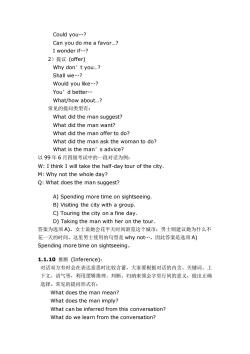
Could you...?Can you do me a favor...?I wonder if...?2)提议(offer)Why don' t you...?Shall we..?Would you like...?You' d better...What/howabout...?常见的提问类型有:What did the man suggest?What did the man want?What did the man offer to do?What did the man ask the womanto do?What is the man' s advice?以99年6月四级考试中的一段对话为例:W: I think I will take the half-day tour of the city.M: Why not the whole day?Q:What does the man suggest?A)Spending more time on sightseeingB)Visiting the city with a group.C) Touring the city on a fine day.D)Takingthemanwith her onthetour.答案为选项A)。女士说她会花半天时间游览这个城市;男士则建议她为什么不花一天的时间。这里男士使用的句型是whynot。因此答案是选项A)Spending more time on sightseeing。1.1.10推断(Inference):对话双方有时会在表达意思时比较含蓄,大家要根据对话的内含、关键词、上下文、语气等,利用逻辑推理、判断、归纳来领会字里行间的意义,做出正确选择。常见的提问形式有:What does the man mean?What does the man imply?Whatcanbe inferredfromthisconversation?Whatdowelearnfromtheconversation?
Could you.? Can you do me a favor.? I wonder if.? 2)提议 (offer) Why don’t you.? Shall we.? Would you like.? You’d better. What/how about.? 常见的提问类型有: What did the man suggest? What did the man want? What did the man offer to do? What did the man ask the woman to do? What is the man’s advice? 以 99 年 6 月四级考试中的一段对话为例: W: I think I will take the half-day tour of the city. M: Why not the whole day? Q: What does the man suggest? A) Spending more time on sightseeing. B) Visiting the city with a group. C) Touring the city on a fine day. D) Taking the man with her on the tour. 答案为选项 A)。女士说她会花半天时间游览这个城市;男士则建议她为什么不 花一天的时间。这里男士使用的句型是 why not.。因此答案是选项 A) Spending more time on sightseeing。 1.1.10 推断 (Inference): 对话双方有时会在表达意思时比较含蓄,大家要根据对话的内含、关键词、上 下文、语气等,利用逻辑推理、判断、归纳来领会字里行间的意义,做出正确 选择。常见的提问形式有: What does the man mean? What does the man imply? What can be inferred from this conversation? What do we learn from the conversation?
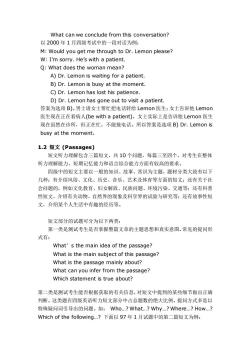
Whatcanweconcludefromthisconversation?以2000年1月四级考试中的一段对话为例:M: Would you get me through to Dr.Lemon please?W:I'm sorry.He's with a patient.Q: What does the woman mean?A)Dr.Lemoniswaitingforapatient.B) Dr. Lemonis busy atthe moment.C)Dr.Lemonhaslosthispatience.D) Dr. Lemon has gone out to visit a patient.答案为选项B)。男士请女士帮忙把电话转给Lemon医生;女士告诉他Lemon医生现在正在看病人(bewithapatient)。女士实际上是告诉他Lemon医生现在虽然在诊所,但正在忙,不能接电话。所以答案是选项B)Dr.Lemonisbusy atthe moment。1.2短文(Passages)短文听力理解包含三篇短文,共10个问题,每篇三至四个,对考生在整体听力理解能力、短期记忆能力和语言综合能力方面有较高的要求。四级中的短文主要以一般的知识、故事、常识为主题,题材分类大致有以下种:有介绍风俗、文化、历史、音乐、艺术及体育等方面的短文;还有关于社会问题的,例如文化教育、妇女解放、民族问题、环境污染、交通等;还有科普性短文,介绍有关动物、自然界的现象及科学界的试验与研究等:还有故事性短文,介绍某个人生活中有趣的经历等。短文部分的试题可分为以下两类:第一类是测试考生是否掌握整篇文章的主题思想和真实意图。常见的提问形式有:What'sthemain ideaof thepassage?What isthemainsubjectof thispassage?What is thepassage mainlyabout?What canyou inferfromthepassage?Whichstatementistrueabout?第二类是测试考生能否根据获取的有关信息,对短文中提到的某些细节做出正确判断。这类题在四级英语听力短文部分中占总题数的绝大比例。提问方式多是以特殊疑问词引导出的问题。如:Who...?What...?Why...?Where...?How...?Whichofthefollowing...?下面以97年1月试题中的第二篇短文为例:
What can we conclude from this conversation? 以 2000 年 1 月四级考试中的一段对话为例: M: Would you get me through to Dr. Lemon please? W: I’m sorry. He’s with a patient. Q: What does the woman mean? A) Dr. Lemon is waiting for a patient. B) Dr. Lemon is busy at the moment. C) Dr. Lemon has lost his patience. D) Dr. Lemon has gone out to visit a patient. 答案为选项 B)。男士请女士帮忙把电话转给 Lemon 医生;女士告诉他 Lemon 医生现在正在看病人(be with a patient)。女士实际上是告诉他 Lemon 医生 现在虽然在诊所,但正在忙,不能接电话。所以答案是选项 B) Dr. Lemon is busy at the moment。 1.2 短文 (Passages) 短文听力理解包含三篇短文,共 10 个问题,每篇三至四个,对考生在整体 听力理解能力、短期记忆能力和语言综合能力方面有较高的要求。 四级中的短文主要以一般的知识、故事、常识为主题,题材分类大致有以下 几种:有介绍风俗、文化、历史、音乐、艺术及体育等方面的短文;还有关于社 会问题的,例如文化教育、妇女解放、民族问题、环境污染、交通等;还有科普 性短文,介绍有关动物、自然界的现象及科学界的试验与研究等;还有故事性短 文,介绍某个人生活中有趣的经历等。 短文部分的试题可分为以下两类: 第一类是测试考生是否掌握整篇文章的主题思想和真实意图。常见的提问形 式有: What’s the main idea of the passage? What is the main subject of this passage? What is the passage mainly about? What can you infer from the passage? Which statement is true about? 第二类是测试考生能否根据获取的有关信息,对短文中提到的某些细节做出正确 判断。这类题在四级英语听力短文部分中占总题数的绝大比例。提问方式多是以 特殊疑问词引导出的问题。如: Who.? What.? Why.? Where.? How.? Which of the following.? 下面以 97 年 1 月试题中的第二篇短文为例:
按次数下载不扣除下载券;
注册用户24小时内重复下载只扣除一次;
顺序:VIP每日次数-->可用次数-->下载券;
- 《大学英语读写》课程教学资源(A)Ⅱ_四级资源_听力_四级听力做题五原则.doc
- 《大学英语读写》课程教学资源(A)Ⅱ_四级资源_听力_听力解题策略及技巧.doc
- 《大学英语读写》课程教学资源(A)Ⅱ_四级资源_作文_英语写作必背句型.doc
- 《大学英语读写》课程教学资源(A)Ⅱ_四级资源_作文_大学英语四六级预测作文范文.doc
- 《大学英语读写》课程教学资源(A)Ⅱ_四级资源_作文_四级作文应试技巧.doc
- 《大学英语读写》课程教学资源(A)Ⅱ_四级资源_作文_四级作文——分析原因类.doc
- 《大学英语读写》课程教学资源(A)Ⅱ_四级资源_作文_四六级十分常用的80个加分搭配.doc
- 《大学英语读写》课程教学资源(A)Ⅱ_四级资源_词汇_篇章词汇解题技巧.doc
- 《大学英语读写》课程教学资源(A)Ⅱ_四级资源_词汇_大学英语四级考试选词填空技巧.ppt
- 《大学英语读写》课程教学资源(A)Ⅱ_四级资源_词汇_四六级使用率最高的580个词汇.doc
- 《大学英语读写》课程教学资源(A)Ⅱ_四级资源_段落翻译_预测段落翻译30篇.doc
- 《大学英语读写》课程教学资源(A)Ⅱ_四级资源_段落翻译_汉译英技巧..ppt
- 《大学英语读写》课程教学资源(A)Ⅱ_四级资源_段落翻译_汉英翻译——-新四级.doc
- 《大学英语读写》课程教学资源(A)Ⅱ_四级资源_段落翻译_四级翻译辅导.ppt
- 《大学英语读写》课程教学资源(A)Ⅱ_四级资源_段落翻译_四级翻译练习材料.doc
- 《大学英语读写》课程教学资源(A)Ⅱ_四级资源_匹配题_阅读信息匹配.doc
- 《大学英语读写》课程教学资源(A)Ⅱ_四级资源_作文_大学英语四级作文讲解.ppt
- 《大学英语读写》课程教学资源(A)Ⅱ_四级资源_词汇_阅读猜词技巧..doc
- 《大学英语读写》课程教学资源(A)Ⅱ_四级资源_词汇_英语四级阅读猜词技巧.ppt
- 《大学英语读写》课程教学资源(A)Ⅱ_四级资源_词汇_英语四级过级考试必须完全熟练的最核心短语(新东方短语表).doc
- 《大学英语读写》课程教学资源(A)Ⅱ_大学英语读写(A)Ⅱ book 3_Unit 1 discovering yourself_AR1.pdf
- 《大学英语读写》课程教学资源(A)Ⅱ_大学英语读写(A)Ⅱ book 3_Unit 5 A place in society_第五单元口语话题参考.ppt
- 《大学英语读写》课程教学资源(A)Ⅱ_大学英语读写(A)Ⅱ book 3_Unit 5 A place in society_课文翻译 Unit 5.ppt
- 《大学英语》课程教学资源(写作技巧)倒装句在文中的妙用.pdf
- 《大学英语》课程教学资源(写作技巧)十大易用的黄金句型.pdf
- 《大学英语》课程教学资源(写作技巧)四六级80个作文搭配1/2.pdf
- 《大学英语》课程教学资源(写作技巧)四六级80个作文搭配2/2.pdf
- 《大学英语》课程教学资源(写作技巧)大学英语四六级作文模板.doc
- 《大学英语》课程教学资源(写作技巧)如何让自己的文章善始善终.pdf
- 《大学英语》课程教学资源(写作技巧)怎么自如地运用比较句型.pdf
- 《大学英语》课程教学资源(写作技巧)把英语句子写活的10种方法.pdf
- 《大学英语》课程教学资源(写作技巧)文章结尾就是填空题1/2.pdf
- 《大学英语》课程教学资源(写作技巧)文章结尾就是填空题2/2.pdf
- 《大学英语》课程教学资源(写作技巧)英语书信的规矩1/2.pdf
- 《大学英语》课程教学资源(写作技巧)英语书信的规矩2/2.pdf
- 《大学英语》课程教学资源(写作技巧)英语写作三段式开头.pdf
- 《大学英语》课程教学资源(写作技巧)英语写作十宗罪.pdf
- 《大学英语》课程教学资源(写作技巧)英语写作高分支招——长短句结合.pdf
- 《大学英语》课程教学资源(写作技巧)议论文常用连接词.pdf
- 《大学英语》课程教学资源(写作技巧)论段落的展开1/6.pdf
